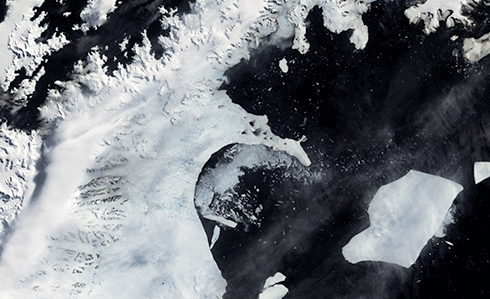
|
Published: 10 February 2014
Sea-level rise: What Antarctica’s Larsen A and B breakup reveals
Global warming is reducing the snow cover of floating ice shelves in Antarctica, putting them at increased risk of disappearing entirely in the next 200 years. With the collapse of the shelves likely to increase global sea-level rise, the only way to prevent this happening, say researchers, is a rapid reduction of greenhouse gas emissions.

|
|
Satellite view of the breakup of the northern part of the Larsen B ice shelf in 2002. Credit:
MODIS, NASA's Earth Observatory
|
In 1995 and 2002, two floating ice shelves in the north of the Antarctic Peninsula (Larsen A and B) suddenly collapsed – each event occurring in a matter of weeks.
This phenomenon was investigated in recent research published in the Journal of Glaciology by scientists at Utrecht University and the British Antarctic Survey. Dr Peter Kuipers Munneke, the paper's lead author, said:
‘This was a spectacular event, especially when you imagine the size of these ice shelves, which are several hundreds of metres thick, and have been in place for over 10,000 years.’
The team of researchers suspected the disappearance of the snow layer on top of the ice shelves could be an important precursor for shelf collapse. Their calculations confirm this hypothesis, and show that many more ice shelves could disappear in the next 200 years.
The scientists believed the snow layer plays an important role in regulating the effect of meltwater lakes on the ice shelves.
As long as the snow layer is sufficiently thick and cold, all meltwater can sink into the snow and refreeze. But in a warmer climate, the amount of meltwater increases, and the snow layers become thinner.
As a result, meltwater can no longer refreeze and forms large lakes on the surface of the ice shelves. The water drains through cracks and faults, causing them to widen until they become so wide and deep that the entire ice shelf disintegrates.
After their collapse, ice shelves can no longer provide resistance to the flow of the glaciers previously feeding them. As a result, the glacier flow accelerates significantly, contributing to an increase in sea-level rise.
The researchers performed calculations that show how this process may evolve over the next 200 years, using two different climate scenarios.
Dr Kuipers Munnekke said: ‘If we continue to burn fossil fuels at the current rate, almost all ice shelves in the Antarctic Peninsula will be under threat of collapse in the next 200 years. Only the two largest ones seem to be safe.
‘Even in the much colder eastern part of Antarctica, some ice shelves could disintegrate. If we manage to keep global warming below 2°C, more than half the ice shelves could be saved, compared to no action being taken on emissions reductions.’
Co-author Prof. David Vaughan said: ‘We've been observing ice-shelf retreat around the Antarctic Peninsula since the early 1990s, but for the first time this model provides a strong basis for the prediction of future changes, which is a major step forward in understanding future sea-level changes.’
Source: British Antarctic Survey/ Ice2sea



